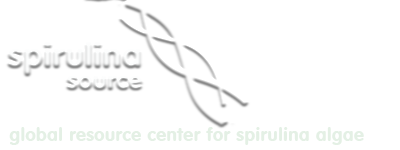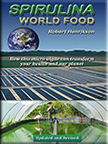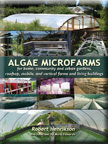REFERENCES AND ABSTRACTS BY HEALTH CATEGORY
Spirulina scientific reference library. Over 100 references covering 45 years of international research.
Click on PDF Download button for free pdf file.
by Shrstha Sinha et al. 2018. Pub. in Frontiers in Neuroscience 18 December 2018 doi: 10.3389/fnins.2018.00966.
Malnutrition has been widely recognized as a grave burden restricting the progress of underdeveloped and developing countries. Maternal, neonatal and postnatal nutritional immunity provides an effective approach to decrease the risk of malnutrition associated stress in adulthood. Particularly, maternal nutritional status is a critical contributor for determining the long-term health aspects of an offspring. Maternal malnutrition leads to increased risk of life, poor immune system, delayed motor development and cognitive dysfunction in the children. An effective immunomodulatory intervention using nutraceutical could be used to enhance immunity against infections. The immune system in early life possesses enormous dynamic capacity to manage both genetic and environment driven processes and can adapt to rapidly changing environmental exposures. These immunomodulatory stimuli or potent nutraceutical strategy can make use of early life plasticity to target pathways of immune ontogeny, which in turn could increase the immunity against infectious diseases arising from malnutrition. This review provides appreciable human and animal data showing enduring effects of protein deprivation on CNS development, oxidative stress and inflammation and associated behavioral and cognitive impairments. Relevant studies on nutritional supplementation and rehabilitation using Spirulina as a potent protein source and neuroprotectant against protein malnutrition (PMN) induced deleterious changes have also been discussed. However, there are many futuristic issues that need to be resolved for proper modulation of these therapeutic interventions to prevent malnutrition.
by Kazuya Masuda et al. 2019. PLoS ONE 14(2): e0211693. https://doi. org/10.1371/journal.pone.0211693.
In developing countries, micronutrient deficiency in infants is associated with growth falter-ing, morbidity, and delayed motor development. One of the potentially low-cost and sustain-able solutions is to use locally producible food for the home fortification of complementary foods. This study aimed to test the hypothesis that locally producible spirulina platensis sup-plementation would achieve the following: 1) increase infant physical growth, 2) reduce mor-bidity, and 3) improve motor development. We randomly assigned 501 Zambian infants into the control group or the spirulina group. Children in the control group (n = 250) received a soya-maize-based porridge for 12 months; those in the spirulina group (n = 251) received the same food with the addition of spirulina. We assessed the change in infants’ anthropo-metric status, morbidity (probable pneumonia, cough, probable malaria, and fever), and motor development over 12 months. The baseline characteristics were not different between the two groups. The attrition rate (47/501) was low. The physical growth of infants in the two groups was similar at 12 months of intervention, as measured by height-for-age z-scores and weight-for-age z-scores. Infants in the spirulina group were 11 percentage points less likely to develop a cough (CI: -0.23, -0.00; P < 0.05) and were more likely to be able to walk alone at 15 months (0.96 ± 0.19) than infants in the control group (0.92 ± 0.28). Home-fortification of complementary foods using spirulina had positive effects on upper respiratory infection morbidity prevention and motor milestone acquisition among Zambian infants.
![]() Spirulina Supplementation in Pregnant Women in the Dakar Region (Senegal)
Spirulina Supplementation in Pregnant Women in the Dakar Region (Senegal)
by Khadim Niang, et al. 2017. Open Journal of Obstetrics and Gynecology, 2017, 7, 147-154 http://www.scirp.org/journal/ojog. ISSN Online: 2160-8806. ISSN Print: 2160-8792.
The fight against iron deficiency anemia in pregnant women is a public health prior-ity, especially in sub-Saharan Africa. Spirulina is an alga very rich in iron, used as a dietary supplement. This research proposes to study its effect on the hemogloblobi-naemia of pregnant women. This was a blind randomized cohort study with a sup-plemented group of spirulina (1500 mg/d) and a second supplemented with iron and folic acid supplementation (IFAS). Included in this study were pregnant women at-tending four health centers in the Dakar region, with pregnancy at 28th amenorrhea, agreeing to participate and not having complications or twin pregnancies. Follow-up of the two groups was identical throughout the study from the 28th week of amenor- rhea to the 42nd postnatal day. The study was conducted among 920 women, evenly distributed among the groups. IFAS allowed a statistically significant increase in he-moglobinemia with an average gain of 0.3 g/dl between the 28th and 32nd weeks of amenorrhea (p = 0.022) and 0.2 g/dl between the 28th week and the delivery (p = 0.043). Spirulina supplementation showed statistically higher gains than those observed with IFAS. These gains were 0.48 g/dl between the 28th and 32nd weeks of amenorrhea and 0.36 g/dl between the 28th week and the delivery, with p values less than 0.001. Spirulina, more accessible to developing countries, is a good option to strengthen the arsenal of iron deficiency anemia control, and therefore maternal mortality.
by Féfé Khuabi Matondo et al. Pub. in JInternational Journal of Pediatrics, Volume 2016, Article ID 1296414, 5 pages, http://dx.doi.org/10.1155/2016/1296414
Aim. Despite high levels of malnutrition, there is still very little information on the nutritional benefits of Spirulina,anaturalalga that provides essential amino acids, rare essential lipids, and numerous minerals and vitamins, to undernourished children in the world. Methods. We carried out a prospective study of 50 children aged between six and 60 months. The intervention group consisted of 16 children who received 10 g of Spirulina daily, as well as the local diet administered by the nutritional centre, and the control group of 34 children who just received the local diet. Both groups of children were assessed on day zero, day 15, and day 30. Results. After treatment, the weight-for-age 𝑍 scores and weight-for-height 𝑍 scores increased significantly in the intervention group. At day 15, there was a statistically significant difference between the mean corpuscular volume, total proteins, and albumin (𝑝 < 0.05)in both groups, in favour of the intervention group, and at day 30, this difference extended to all of the studied parameters (𝑝 < 0.05). Conclusion. This study found that the nutritional status of undernourished children who received Spirulina supplementsaswellas the local diet administered by the nutritional centre improved quickly and significantly.
by Hubert Barennes et al. Pub. in Barennes et al. BMC Pediatrics. (2022) 22:701. https://doi.org/10.1186/s12887-022-03766-5.
Background: Spirulina (SP) is widely used as a nutritional supplement to enhance child nutrition in low-income countries. We assessed Spirulina’s efficacy of the current dose supplied by institutions in Cambodia on improving growth and anemia in a cross-over randomized controlled trial in preschool underprivileged children from similar settings.
Methods: Preschool children cared by a not-for-profit institution were randomly and blindly allocated (2 to 1) to spir-ulina or placebo: 100 g in total, given in 2 g per day. After 5 weeks of wash-out, participants were crossed-over to the other group. Anthropometric gain and selected hematological data (blood cell count, ferritin, and C-reactive protein) were assessed at each phase.
Results: A total of 179 children completed the trial, 149 (83.2%) completed all the anthropometrics, and 99 (55.3%) all hematological measures. Mean BMI was 14.18 (95%CI: 14.00–14.37) and 31(20.8%) children had thinness. Mean blood hemoglobin was 11.9 g/dL (95%CI: 11.8–12.1). The weight gain of the SP group showed a modest higher trend
compared to placebo (0.63 kg; 95%CI: 0.54–0.72 and 0.46 kg; 95%CI: 0.33–0.58, respectively; p = 0.07). Height increased similarly in both groups. The number of anemic children decreased by 6 (6.06%) and 11 (11.11%) on Placebo or SP, respectively (p = 0.004). Tolerance was good.
Conclusion: SP may be recommended to improve childhood anemia. The analysis of the usual daily dose (2 g) pro-vided by organizations in Cambodia shows a tendency to improve weight gain in the group supplemented with SP very close to significance, but no trend in height. Increased doses and longer supplementation should be evaluated further.
by Frank Stephane Winter et al. Pub. in JNutrients 2014, 6, 2973-2986; Cameroon.
Dietary supplements are often used to improve the nutritional status of people living with HIV/AIDS (PLHIV). Arthrospira platensis (Asp), also known as Spirulina, is a cyanobacterium rich in proteins and micronutrients. Cell and animal trials described immune-modulating, antiretroviral and antioxidant activities. This pilot study describes the effects of the supplementation of 5 g/day of Asp on a pre-highly-active antiretroviral therapy (pre-HAART), HIV-infected, adult female population. It was conducted as a three-month randomized controlled trial (RCT) that compared a cup supplementation of five grams/day of Asp with a placebo of equal protein content and energy. The study included 73 HIV-infected women. The immediate outcome variables were CD4 T-cells, viral load and immune activation by CD8 T-cells expressing CD38. The antioxidant status was assessed by way of the total antioxidant capacity of the serum (TAOS). The renal function was documented by way of creatinine, urea and the calculated glomerular filtration rate. Statistical analyses were carried out with non-parametric tests, and the effect size of each interaction was calculated. No differences in the immunological and virological markers between the Asp and the placebo group could be observed. In the placebo group, 21 of 30 patients (70%) developed concomitant events, while in the Asp group, only 12 of 28 patients (43%) did. Both groups registered a significant weight increase; 0.5 kg (p < 0.05) in the Asp group and 0.65 kg (p < 0.05) in the placebo group. The antioxidant capacity increase of 56 (1–98) µM for Asp was significantly different from the decrease observed in the placebo group (p < 0.001). A slight increase in the creatinine level of 0.1 g/dL (p < 0.001) was observed in the Asp group, and no effect was observed in the urea levels. The improvement of the antioxidant capacity under Asp, shown for the first time on PLHIV, could become a focus for future research on the nutritional and health effects of Spirulina. The observed slight, but significant increase of serum creatinine needs further evaluation, especially with varying doses of Asp.




